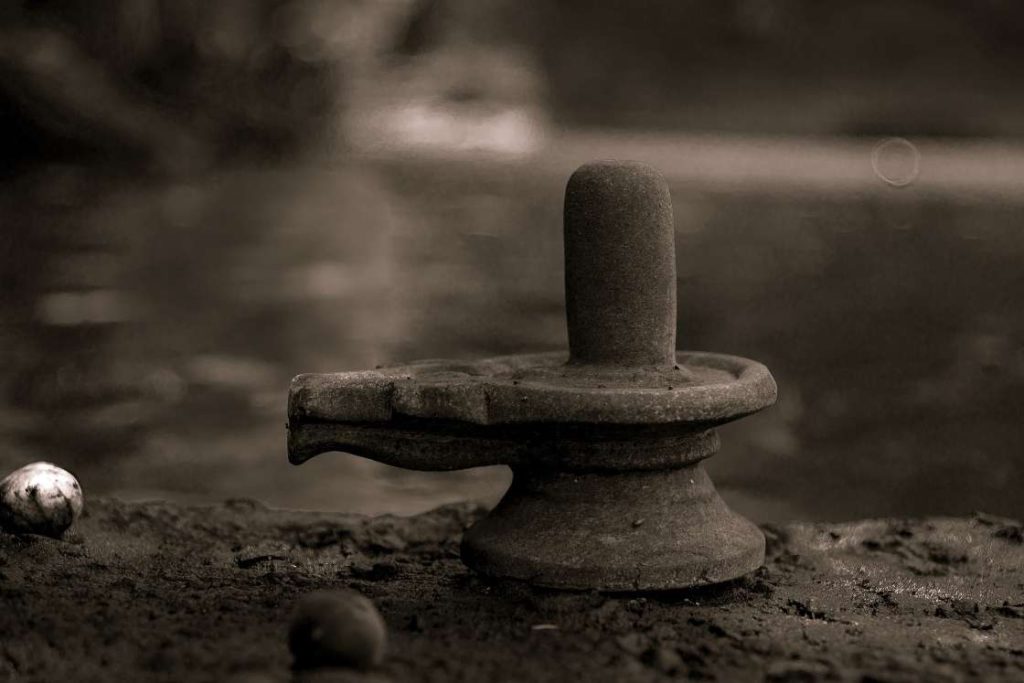
Linga Mudra is a hand gesture practiced in yoga and meditation. It involves interlocking the fingers of both hands with the thumbs pointing upwards. This mudra is believed to generate heat in the body and enhance respiratory functions. In Hindu symbolism, the upright thumb in Linga Mudra represents Lord Shiva, signifying masculine energy and creation.
Meaning & Significance

The shape of the hands and upright thumb in linga mudra looks similar to the erect penis (phallus). In Sanskrit, the phallus is termed as Linga, hence this mudra is called Linga mudra. It’s also called “upright mudra“.
Interlocked fingers in linga mudra make the firm oval-shaped foundation that holds the upright formless structure. The bottom interlaced fingers represent the Supreme Power that holds the entire Universe on it and the straight thumb shows the creation.
In Hinduism, Lord Shiva is worshipped in many forms, and Shiva Linga as Lingeshwara; lord of the phallus is most common among all. The reason for worshipping Shiva Linga comes from the fact it symbolizes masculinity and has the power of creation.
How to Do Linga Mudra?

- Sit comfortably in a meditation posture or any seated position with a straight spine.
- Bring your hands together in front of your chest.
- Interlock the fingers of both hands, ensuring that the knuckles are pointing outward.
- Extend your thumbs upward, keeping them straight.
- You can rest your hands on your lap, with the mudra positioned near your solar plexus.
- Hold the mudra with gentle pressure and maintain a relaxed breathing pattern.
- Practice Linga Mudra for about 15 minutes at a time, gradually increasing to 45 minutes per day if desired.
Body Postures to Perform Linga Mudra
Linga mudra can be performed in different seated and standing positions. You can casually sit in a chair, with an erect spine and try this mudra. This is the most casual way of practicing. However, in a yoga way, perform mudra sitting in a sukhasana, padmasana, or any other cross-legged sitting pose. The cross-legged sitting poses will enhance your immunity, metabolism, and concentration. You can also sit in a Vajrasana that will enhance the digestion benefits.
However, if one wants, one can do linga mudra in the standing or walking position as well. While doing so, stand straight with your legs hip-width apart. Keep your spine erect, maintain length in your spine, press your shoulders down, and push back your head in the line of your hip.
Benefits of Linga Mudra
- Heat Generation and Immune Support: The primary benefit of Linga Mudra lies in its capacity to generate heat, which can help the body fight off infections, colds, and respiratory disorders. By stimulating the fire element, Linga Mudra boosts immunity and supports overall wellness.
- Metabolism Enhancement: Linga Mudra’s ability to increase internal heat can also enhance metabolism, making it beneficial for those seeking weight management and digestive support.
- Respiratory Health: Through deep breathing and the stimulation of lung capacity, Linga Mudra may improve respiratory functions and increase oxygen levels in the body, aiding in conditions like asthma and bronchitis.
- Energy Balancing: Linga Mudra works to balance the body’s energy by harmonizing the interaction between the air and fire elements. This balance promotes vitality, vigor, and a sense of well-being.
- Mind-Body Connection: As with many yogic practices, Linga Mudra fosters a deep connection between the mind and body, promoting relaxation, focus, and mental clarity.
Linga Mudra’s Impact on the Three Doshas
The five fingers in your hands represent five elements (and thus different groups of energies, Vata, pitta, Kapha,) fire, air, space, earth, and water.
The finger interlocking technique of Linga Mudra allows the elements air, space, and earth to merge and overlap and lets the elements air and fire stand out. This mudra will increase the interaction between air and fire elements; air always helps the fire to spread. The fire represents the heat and vitality of your body. This mudra uses the air element to stimulate the fire element and spread the force of vitality and vigor throughout your body and mind.
The Linga Mudra establishes Pitta (air and fire)- Kapha (water and earth) balance in your body. Pitta stimulating nature (stimulation to digestion and metabolism) of linga mudra will ensure, the Kapha energies are in check. Excessive Kapha energies can cause issues like depression, lethargy, asthma, and weight gain.
How Long to Practice Linga Mudra?
Yoga mudras are generally practiced for 45 minutes a day. It is important that even for Linga mudra you strictly adhere to this time duration.
Overdoing linga mudra can increase your body temperature beyond safe limits. Overdoing may break the Pitta-Kapha balance and could make you feel sluggish or feverish. Also, it can show side effects such as high blood pressure, heavy sweating, nausea, and dehydration.
As a matter of fact, these sensations can be considered as duration-determining parameters. Once you start to get these sensations, it is for sure that you need to reduce your overall duration.
Different people have different constructs so if you start feeling heating sensations, even before 45 minutes of practice, you will have to shorten your duration further. For starters don’t attempt 45 minutes at a stretch but in three parts of 15 minutes each.
When to Perform?
Linga mudra can be performed at any time, it’s just you will have to ensure that before performing your body temperature is normal and cardiac and respiratory vitals are normal.
You can practice linga mudra in the morning and evening. Morning and evening practice sessions will boost the immunity and temperature regulation benefits of the mudra. Since this mudra helps with digestion, it might be an instinct to practice directly after meals, but that would be a bad idea. The digestive benefit is more of an indirect benefit. The direct benefit however is increasing your body temperature, which can be counterproductive on a full belly.
Preparatory Exercise
Linga Mudra will optimize your body temperature and immunity system. But some preparatory exercise can further enhance these benefits. One such exercise is practicing “Throw The Illness Behind You,” before Linga Mudra.
- Stand straight with your spine erect
- Keep your legs a little wider than hip-width distance.
- Raise your hands straight in front of your body at shoulder levels.
- Bend your legs at your knees, and slightly bend down like squatting.
- While inhaling throw your arms at the back and turn to your right looking over the shoulder.
- Then while exhaling, turn your head and hand to the initial position.
The linga mudra also goes pretty well with meditation. Calm your mind and focus on eliminating your negative thoughts. If necessary use means like single point concentration, music concentration, or even mantras. You can even chant simple self-affirmative slogans like, “I offer all negative qualities in the fire of transformation.”
Precautions and Contradictions
- Avoid consuming excess body-heating foods like red meat, animal fat, processed food, and fatty dairy before practicing Linga Mudra due to its potent heat-boosting effects.
- Refrain from activities that increase body temperature throughout the day, particularly after practicing Linga Mudra.
- Be cautious with exercise selection and duration, especially if combining with other workout routines.
- Avoid practicing Linga Mudra if you have conditions such as menopause, thyroid disorders, ulcers, hypertension, migraines, or a recent stroke.
Conclusion
Linga Mudra stands as a testament to the ancient wisdom of yoga and meditation, offering a pathway to holistic health and well-being. By incorporating this simple yet powerful practice into your daily routine, you can tap into its transformative potential and experience the profound benefits it has to offer. With mindfulness, patience, and dedication, Linga Mudra can become a valuable tool for nurturing your body, mind, and spirit on the journey to optimal wellness.

